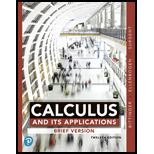
Pearson eText Calculus and Its Applications, Brief Edition -- Instant Access (Pearson+)
12th Edition
ISBN: 9780136880257
Author: Marvin Bittinger, David Ellenbogen
Publisher: PEARSON+
expand_more
expand_more
format_list_bulleted
Concept explainers
Textbook Question
Chapter E, Problem 13E
Solve each integral using Table 1.
13.
Expert Solution & Answer
Want to see the full answer?
Check out a sample textbook solution
Students have asked these similar questions
Find the indefinite integral.
Check
Answer:
In(5x)
dx
x
Find the indefinite integral.
Check
Answer:
7x
4 + 1x
dx
Here is a region R in Quadrant I.
y 2.0 T
1.5
1.0
0.5
0.0 +
55
0.0 0.5
1.0
1.5
2.0
X
It is bounded by y = x¹/3, y = 1, and x = 0.
We want to evaluate this double integral.
ONLY ONE order of integration will work.
Good luck!
The
dA =???
Chapter E Solutions
Pearson eText Calculus and Its Applications, Brief Edition -- Instant Access (Pearson+)
Ch. E - Prob. 1ECh. E - Prob. 2ECh. E - Prob. 3ECh. E - Prob. 4ECh. E - Prob. 5ECh. E - Prob. 6ECh. E - Prob. 7ECh. E - Prob. 8ECh. E - Prob. 9ECh. E - Prob. 10E
Ch. E - Solve each integral using Table 1. 11. In3xdx,x0Ch. E - Solve each integral using Table 1. 12. In45xdx,x0Ch. E - Solve each integral using Table 1. 13. x4Inxdx,x0Ch. E - Prob. 14ECh. E - Prob. 15ECh. E - Prob. 16ECh. E - Prob. 17ECh. E - Prob. 18ECh. E - Prob. 19ECh. E - Prob. 20ECh. E - Prob. 21ECh. E - Solve each integral using Table 1. 22. 9t21dtCh. E - Solve each integral using Table 1. 23. 4m2+16dmCh. E - Solve each integral using Table 1. 24. 3inxx2dxCh. E - Prob. 25ECh. E - Prob. 26ECh. E - Prob. 27ECh. E - Prob. 28ECh. E - Prob. 29ECh. E - Prob. 30ECh. E - Prob. 31ECh. E - Prob. 32ECh. E - Evaluate using Table 1 33. 83x22xdxCh. E - Evaluate using Table 1 34. xdx4x212x+9Ch. E - Evaluate using Table 1 35. dxx34x2+4xCh. E - Prob. 36ECh. E - Prob. 37ECh. E - Prob. 38ECh. E - Prob. 39ECh. E - Prob. 40ECh. E - Prob. 41E
Knowledge Booster
Learn more about
Need a deep-dive on the concept behind this application? Look no further. Learn more about this topic, calculus and related others by exploring similar questions and additional content below.Similar questions
- 43–46. Directions of change Consider the following functions f and points P. Sketch the xy-plane showing P and the level curve through P. Indicate (as in Figure 15.52) the directions of maximum increase, maximum decrease, and no change for f. ■ 45. f(x, y) = x² + xy + y² + 7; P(−3, 3)arrow_forwardEX-let d'be ametric on a vector space X induced from a norm hx and d defind by a Slab)= {od (a, if a = b (a,b)+is ab Show that cannot be induced froman norm on X. 2) let à be trivel metric show that I cannot be induced from an norm on X- 3) let M be closed subspace of anormed spacex Construct the space X/Mas a normed space. 4) let Mix be vector space of 2x3 matrices on R write with Prove convex set and hyper Plane of M 5) show that every a finite dimension subspace of anormed space is closed.arrow_forwardplease do #48arrow_forward
- 43–46. Directions of change Consider the following functions f and points P. Sketch the xy-plane showing P and the level curve through P. Indicate (as in Figure 15.52) the directions of maximum increase, maximum decrease, and no change for f. ■ 45. f(x, y) = x² + xy + y² + 7; P(−3, 3)arrow_forwardplese do #48arrow_forward43-46. Directions of change Consider the following functions f and points P. Sketch the xy-plane showing P and the level curve through P. Indicate (as in Figure 15.52) the directions of maximum increase, maximum decrease, and no change for f. T 45. f(x, y) = x² + xy + y² + 7; P(−3, 3)arrow_forward
arrow_back_ios
SEE MORE QUESTIONS
arrow_forward_ios
Recommended textbooks for you
- Algebra & Trigonometry with Analytic GeometryAlgebraISBN:9781133382119Author:SwokowskiPublisher:Cengage
 Algebra: Structure And Method, Book 1AlgebraISBN:9780395977224Author:Richard G. Brown, Mary P. Dolciani, Robert H. Sorgenfrey, William L. ColePublisher:McDougal Littell
Algebra: Structure And Method, Book 1AlgebraISBN:9780395977224Author:Richard G. Brown, Mary P. Dolciani, Robert H. Sorgenfrey, William L. ColePublisher:McDougal Littell Mathematics For Machine TechnologyAdvanced MathISBN:9781337798310Author:Peterson, John.Publisher:Cengage Learning,
Mathematics For Machine TechnologyAdvanced MathISBN:9781337798310Author:Peterson, John.Publisher:Cengage Learning, 

Algebra & Trigonometry with Analytic Geometry
Algebra
ISBN:9781133382119
Author:Swokowski
Publisher:Cengage

Algebra: Structure And Method, Book 1
Algebra
ISBN:9780395977224
Author:Richard G. Brown, Mary P. Dolciani, Robert H. Sorgenfrey, William L. Cole
Publisher:McDougal Littell

Mathematics For Machine Technology
Advanced Math
ISBN:9781337798310
Author:Peterson, John.
Publisher:Cengage Learning,

Definite Integral Calculus Examples, Integration - Basic Introduction, Practice Problems; Author: The Organic Chemistry Tutor;https://www.youtube.com/watch?v=rCWOdfQ3cwQ;License: Standard YouTube License, CC-BY